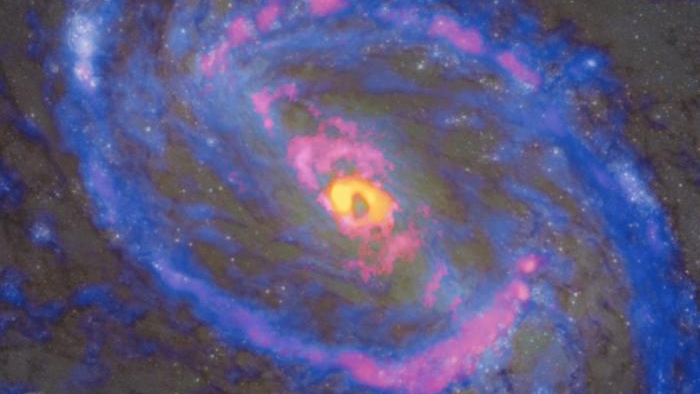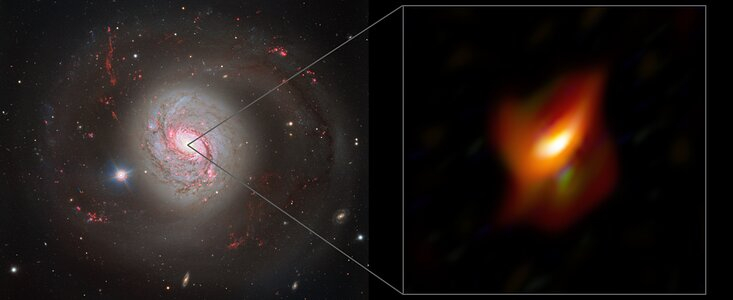Heart of the 'Squid Galaxy' reveals how supermassive black holes dictate galactic chemistry
Scientists studied the Squid Galaxy, Messier 77, to determine how chemicals swirl around its shrouded central black hole.

New research has revealed how supermassive black holes that lurk at the hearts of large galaxies influence the distribution of chemicals throughout their entire galactic homes.
Scientists have long understood that supermassive black holes have a massive influence on the galaxies around them. In particular, as these black holes feed from matter surrounding them, they form electromagnetic radiation emissions that are bright enough to outshine the combined light of every star in their home galaxy. This active feeding process also causes jets of matter to blast outwards from the black hole at near the speed of light.
Combined, these phenomena deem the galactic heart an active galactic nucleus (AGN) and heat gas and dust as well as push star-forming matter away from the region, which can limit star births and, thus, inhibit growth of the galaxy itself. However, scientists don’t understand as clearly how the distribution of chemicals in galaxies is influenced by AGNs and their supermassive black hole engines.
The new research was conducted by a team of astronomers that used the Atacama Large Millimeter/submillimeter Array (ALMA) to look at the supermassive-powered AGN of the galaxy NGC 1068, also known as Messier 77 (M77) or simply, the "Squid Galaxy." In particular, the researchers were interested in parsing the distribution of chemicals around the bright heart of this barred spiral galaxy, located 51.4 light-years away from Earth, in the constellation Cetus. The black hole associated with this AGN is shrouded by a thick ring of dust called circumnuclear disk and surrounded by a region of intense star birth called the starburst ring.
Related: Powerful observatories reveal 5 breathtaking corners of the universe hidden to human eyes (images)
"Recently, an important and interesting issue about galaxies has been the investigation of power sources in active galaxies, focusing especially on the obscured galactic nuclei, which are the central engines of the galaxy starburst or AGN," the team behind the research writes in a paper published in the Astrophysical Journal. "Observations revealing the power sources may provide key information regarding the evolution of galaxies. The chemistry-based approach, which involves the use of line surveys in galaxies, is an effective way of solving this problem."
Thanks to the impressive spatial resolution ability of ALMA and the employment of a new machine learning technique, the team was able to map the distribution of 23 molecules present in the galaxy.
Breaking space news, the latest updates on rocket launches, skywatching events and more!

This is possible because chemical elements and compounds absorb light at characteristic wavelengths, so by looking at light shining through gas and dust, scientists can see "lines," or gaps, where light has been absorbed. This shows the chemical composition of the dust and gas.
In particular, the team observed that isotopes of hydrogen cyanide were confined to the central region of the AGN, while cyanide radicals were also located at the galaxy’s active center but blasted outwards too, in jets extending from both poles of the supermassive black hole.
The researchers also spotted that, unlike these two molecules, carbon monoxide isotopes — common in galaxies — steered clear of the central region.
To the team, this is clear evidence of supermassive black holes affecting not just the large-scale structure of galaxies but also their chemical composition. The research delivered some surprises for the researchers, too, with the team finding that high-energy X-rays from the AGN had less of an impact on chemical distribution than theorized.
"The abundance of cyanide in the circumnuclear disk is significantly lower than the expected value of the model calculations in the region affected by strong radiation," the authors concluded. "The expected strong X-ray irradiation from the AGN has a relatively lower impact on the molecular abundance in the circumnuclear disk than mechanical feedback."
A paper on this research was published Sept. 14 in The Astrophysical Journal
Join our Space Forums to keep talking space on the latest missions, night sky and more! And if you have a news tip, correction or comment, let us know at: community@space.com.

Robert Lea is a science journalist in the U.K. whose articles have been published in Physics World, New Scientist, Astronomy Magazine, All About Space, Newsweek and ZME Science. He also writes about science communication for Elsevier and the European Journal of Physics. Rob holds a bachelor of science degree in physics and astronomy from the U.K.’s Open University. Follow him on Twitter @sciencef1rst.
